CAPSULE HISTORY OF THE
U.S. Navy MkV Diving Helmet
by Jim Boyd with historical research by Leslie Leaney
PHOTOGRAPHY BY JIM BOYD
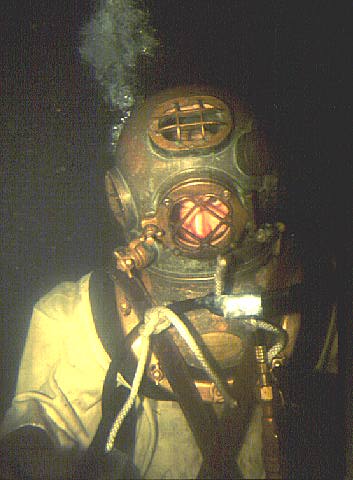
JIM FOLK'S 1944 Desco MkV in the training tank
of the International Commercial Diving Institute in Wilmington, Delaware.
IT IS PROBABLY the most recognized image in American diving -- the very embodiment of the term "deep sea diver." It's the U.S. Navy Mkv divinig helmet, and its reputation is well earned over 60 years of military and continued use in civilian diving today.
In this era of SuperLites, teck diving and computer-generated decompression tables, the Mark Five (written "MkV") is a product of Civil War physics and blacksmith engineering: simple and reliable.
The idea of a rigid helmet and closed flexible dress dates back to Augustus Siebe in England in 1831, and by the Turn of the Century (1900) helmet diving on compressed air had become a fairly well-developed art with a variety of commercial equipment manufacturers around the world. The helmets generally followed Siebe's concept of a breastplate and three-light bonnet (the windows are known as "lights") with an interrupted-thread locking neck ring. In 1907 the Royal Navy had standardized its "Admiralty Pattern" rig based on the Siebe design.
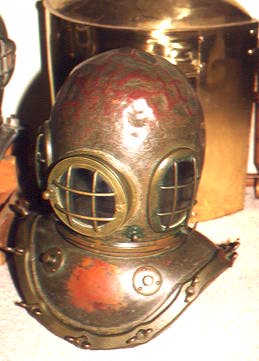
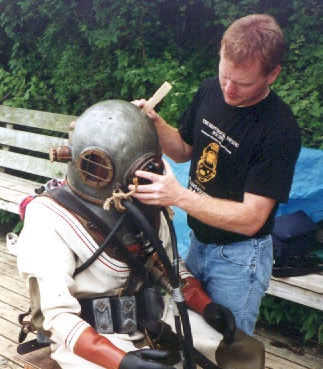
ONE OF THE EARLIEST Siebe helmets (left), dating to the late 1830s, owned by Leslie Leany, illustrates the standard pattern of the three-light helmet. Mark Butler's modern Schrader commercial helmet (right) retains the rear-mounted exhaust valve with internal head button and the screw-in faceplate, being applied by Jim Folk.
In 1912 U.S. Navy Gunner G.D. Stillson submitted a report to the Bureau of Construction & Repair that was critical of the Navy's equipment and diving techniques. Two years later he was assigned the task of running a series of tests to evaluate existing equipment and recommend a U.S. Navy standard. At that time the Navy was using commercial helmets designed and manufactured by Morse of Boston and Schrader of Brooklyn, N.Y. Stillson's team also tested the British Admiralty Pattern gear and equipment from Draeger of Germany.
With his trial-and-error testing completed and following interviews with working Navy and commercial divers, Stillson presented his document, The Report on Deep Diving Tests 1915, which contained a three-view drawing of a recommended helmet design that is immediately recognizable as the genesis of the MkV.
Stillson's recommended design varied from most of the contemporary commercial helmets in some important ways. Instead of three lights, it had four, adding one above the faceplate for an upward view. And the faceplate itself was unique in that it was hinged, whereas almost all faceplates of its day were of the screw-in variety (the hinged faceplate would make the MkV "sailor-proof," eliminating the possibility of a slip of the hand losing the faceplate overboard and rendering the entire rig useless).
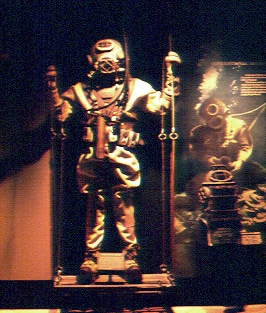
A CLASSIC MkV was displayed at the Smithsonian Institution in the 1970s.
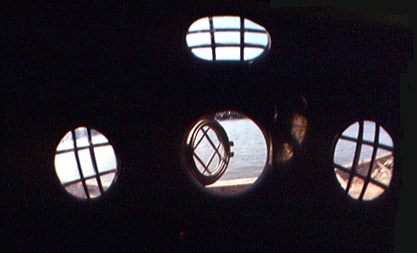
THE VIEW FROM INSIDE a MkV shows the front, top and side lights and the hinged faceplate.
One of the most popular aspects of Stillson’s design was the positioning of the exhaust control valve near the right front of the bonnet instead of behind the head, where it was often very difficult to reach and manipulate. The rear position was logical, because it kept the exhaust bubbles away from the faceplate and side lights, where they would obscure the diver's vision. Stillson resolved this by placing the actual valve near the diver's right jaw and ducting the bubbles back through an external "bananna tube" to an exhaust port in the conventional location at the rear.
The very first diving helmet ever built (by Augustus Siebe for the Deane brothers in 1829) had its inlet air ducted inside the helmet to flow out over the windows to keep the glass from fogging up. This became standard on virtually all the three-light helmets that followed. Adding Stillson’s top light, however, made ducting to the all-important faceplate somewhat difficult. So a “spit cock” valve was added adjacent to the faceplate on the right side so the diver could take in a mouthful of outside water to spit onto the faceplate to clear it (there wasn’t much concern over pollution or nuclear containment diving in 1915). The prototype U.S. Navy MkV diving helmet, produced by Morse in 1916, rather closely followed Stillson’s published design. Within a very short time, however, the “standard” MkV emerged with some slight variations: The spit cock was moved from the right side to the left, and the exhaust valve was moved further forward into its place. This permitted the spit cock to be on the opposite side of the helmet from the exhaust valve, so that in cases where the diver was working on his right side in mud or sand (which could plug up the exhaust port) the spit cock could be used as an auxiliary manual exhaust valve. Although some MkV’s were individually modified over the years, “official” variations were rare and subtle (the eight-point exhaust valve wheel was replaced by a four-point wheel, for instance, and the the vertical goosenecks at the back of the helmet were angled inward so that the communication and air supply lines would cross behind the diver’s back).
Conventional helmet design in 1915 tended toward smaller bonnets to reduce the displacement of the helmet and its tendency to float, thus reducing the weight required to keep it down. The bonnet of the MkV is slightly bigger than most helmets of its time, and that trait proved to be one of its best features. The size gave it greater displacement and required more weight to neutralize, but the volume of available air made it an extremely comfortable helmet in which to work. The design had little to do with air volume, however, for the large bonnet was designed to go over a set of headphones and mouthpiece speaker worn by the diver for communications, even though the built-in two-way comm speaker was part of the original production model. The need for more weight to "sink" the helmet mandated the use of a weight belt rather than the breastplate weights then commonly in use. This actually made the rig much easier to handle both in the water and on the surface, as the weight was better distributed and focused around the diver's natural center of gravity, rather than being top-heavy around the chest.
The MkV differs from the Admiralty Pattern gear in that it is intended to be used with a weight belt rather than breastplate weights and also in being designed for use with an air control valve. The Admiralty Pattern rig was designed for use with a hand pump and depends on the surface operators to adjust the diver’s air flow through voice communication or liine-pull signals -- the diver himself has only the exhaust valve on the back of his helmet to control his buoyancy. The MkV was designed from the onset to be used with a power-driven air compressor and has an air control valve positioned for the diver’s left hand to regulate the incoming air (when being used with a hand pump, the MkV is generally dived with the air control valve wide open and the diver using the surface to regulate the air flow, to avoid the men on the pump having to work against a closed valve). With the air control valve, the MkV diver has total control of both inbound and exhaust air flow without having to communicate with the surface.
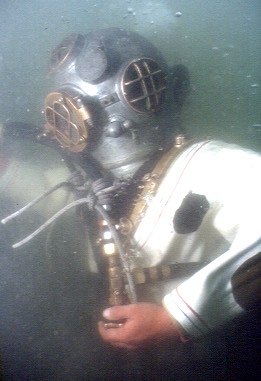
THE MkV IS DIVED using an air control valve on the
incoming air line manipulated by the diver's left hand,
as shown here. The spit cock shows clearly on the lower side
of the bonnet between the front and side lights.
The external "bump" beside the top light is a recess
for the internal communications telephoner speaker.
The Morse and Schrader companies produced the first MkV's (among the earliest in the Historical Diving Society members’ collections are Leon Lyons’ Schrader serial number H20 of 1917 and Leslie Leaney’s Morse 2289 of February 24, 1917). Judging by known serial numbers, Schrader produced about 600 World War I era MkV’s, and the Morse numbers are likely similar.
Public fame was achieved by the MkV in May 1939 when it was used by the Navy divers who reached the sunken U.S. submarine Squalus in 240 feet of water and subsequently rescued 33 crewmen from the bottom of the Atlantic. Air-supplied MkV’s were used for the initial Squalus rescue, and since the job took the divers about 50 feet deeper than is considered safe for air-supplied work (because of the dangers of nitrogen narcosis, which produces a dangerously "drunken" effect on the diver) the rescue divers were awarded the only Congressional Medals of Honor bestowed on anyone between the two World Wars.
Since heavy gear like the MkV is subject to exactly the same laws of physics that apply to today's scuba divers, a mixed-gas version of the MkV had been developed in the 1930s for work deeper than 180 feet. These replaced the nitrogen in the air mix with helium, which does not have the toxic effect under pressure of nitrogen, with a trickle of oxygen fed in to replace that breathed by the diver. A large canister of absorbent was attached to the back of the MkV gas hat to scrub the carbon dioxide from the diver's exhaled breath. Since helium conducts heat more rapidly than nitrogen, the MkV gas hat was designed for use with electrically-heater underwear -- an additinal gooseneck was built into the helmet for the power connection from the surface! All of this added weight to an already heavy rig, and the gas hats were equipped with lifting rings on the top to support the weight of the helmet with a hoist when the diver was dressing on the surface. Helium MkV’s were used for the long-term salvage operation on the Squalus. To keep the diver from venting the valuable helium gas accicentally, the spit cock was eliminated, and a fourth duct was added inside to ventilate the faceplate.

A MkV GAS HAT on display at Frank's Fisherman's Supply
in San Francisco shows the absorbant canister on the back
of the helmet and the top lifting ring. The three goosenecks
across the top are (l to r) for the communications line, electric
underwear heating power line and breathing gas supply line.
The "nub" beyond them is the special non-return exhaust outlet.
The MkV really came into its own during World War II, when it was firmly established as the standard U.S. Navy diving rig and was used for nearly all dive training, heavy salvage and repair work. With the demands of two nautical theaters of war, MkV production escalated to impressive levels. Miller Dunn of Miami began producing modest numbers, and Divers Equipment & Salvage Company (Desco) of Milwaukee set up a large production line and began cranking out MkV’s by the hundreds. During the war, Desco employed 87 people in the production of diving gear, including eleven women in “Rosie the Riveter” roles on various parts of the manufacturing line. Bernice McKenzie, who later became vice president of Desco, was hired in October 1942 as a solderer assembling MkV’s and recalls that all of the copper bonnet shells were “spun” by one skilled individual — she doesn’t remember his name but recalls that he was, “a great big man.” Navy orders would be for 700 or 800 helmets at a time, and they would be shipped out in batches of 100 or 200. It is estimated that production of MkV’s from the four manufacturers over the years ranges from 7000 to 10,000 total units — and Desco will still produce them to order (about $3800 F.O.B. Milwaukee).
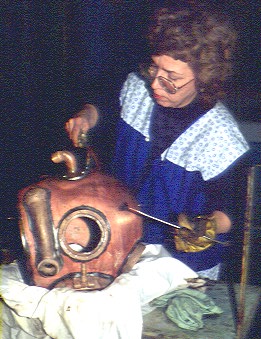
"ROSIE THE RIVETER" (actually the solderer) is still employed
at Desco in Milwaukee. In 1995 she was soldering a gooseneck
into one of the HDS-USA commemorative MkV's under construction.
The MkV was decommissioned by the Navy in 1979, replaced by the Mk12 free-flow air hat — which has been subsequently replaced by a Navy version of the SuperLite. Today MkV’s are collector’s items (the small-production Miller Dunn’s and old eight-point-exhaust-valve versions being the most sought-after), although they are still being used by many civilian commercial diving operations. While the helmets are indestructible, it’s the replacement cost of worn-out diving dresses that will likely spell their demise.
The MkV is as useful today as it was in 1917, and for some jobs there isn’t a modern rig that can match it. At a joint Historical Diving Society and Association of Diving Contractor’s affair in Santa Barbara, California, recently, somebody in the crowd watching a MkV diver being dressed commented, “Those old deep sea rigs are completely gone today.” An ADC dive contractor just looked over and matter-of-factly countered, “Oh yeah, well I’ve got six MkV’s in the water on jobs in the Midwest as we speak.”
’Nuff said.
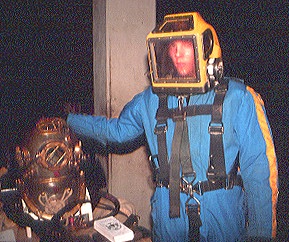
THE NAVY Mk12 replaced the MkV rig in 1979.
This free-flow air hat is mated to a neoprene drysuit
that is worn inside a nylon coverall that carries
its weights in pouches on the diver's legs.
The Mk12 has since been replaced by a version of the SuperLite demand helmet.
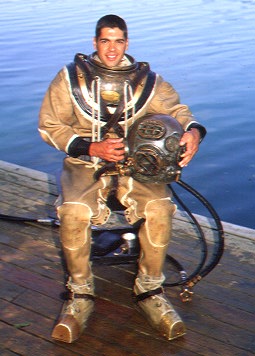
AN AUTHENTIC MkV RIG, owned by Jim Folk, is dived regularly
by the Northeast Working Equipment Group at Willow Springs
Quarry Park near Reading, Pennsylvania. The U.S. Navy "MkV"
is a complete rig, not just a helmet. The only thing missing
from this standard rig is the round knife sheath. The legs of the
canvas dress are laced in the back to avoid overinflating underwater.
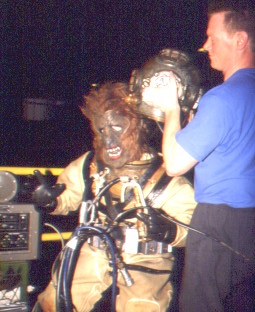
WHILE THE MkV rig is subject to exactly the same laws
of gas diving physics as modern gear, on some occasions
it has been noted that taking a bad "hit" of nitrogen narcosis
on a too-deep dive on air can produce spectacular results.
"Yep, he's been narced!"










